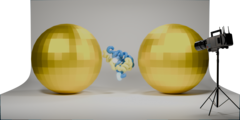Wednesday, 24 January, 2024
"Slow motion" recordings of biomolecules
Scientists from the Department of Chemistry at LMU Munich led by Prof. Philip Tinnefeld have developed a new method to watch biomolecules such as proteins and DNA at work.
Amateur filmmakers are aware of the problem: when shooting slow-motion films, you eventually reach the limits of the camera - the film gets darker the more frames per second are captured. This is because less light falls on the detector at shorter exposure times. Eventually, the image will be so dark that no information can be obtained from the images anymore. A similar problem is encountered in biophysical chemistry. Of particular interest here are biomolecules such as proteins and nucleic acids (DNA and RNA). Here, too, higher time resolution is needed to provide insights into processes such as protein folding or the binding of drugs to their receptors.
To observe the movements of individual biomolecules, the energy transfer process FRET is often used. In this process, molecules are labeled with two fluorescent markers that can be detected in a fluorescence microscope. Through FRET, one of the fluorescent markers can transfer its energy to the other, causing the originally excited marker to become darker and the other marker to become brighter. The amount of energy transferred depends on the distance between the two markers and can be determined very precisely. Such an experiment requires high sensitivity and therefore state-of-the-art microscopy setups. The faster the process to be observed, the brighter the fluorescent markers must glow in order to observe it; at the same time, the risk of destroying the fluorescent marker increases with stronger excitation intensity, making it extremely difficult to observe processes on the microsecond timescale in real time.
Scientists led by LMU chemist Philip Tinnefeld have now developed a new method to improve the signal intensity in such experiments and thus also the time resolution by a factor of 10. To do this, they placed the molecules in a so-called DNA origami nanoantenna. These are nanostructures consisting of a DNA scaffold and two metallic nanoparticles. By selectively placing the biomolecules in the zeptoliter-sized volume between the nanoparticles, the fluorescence intensity of the dyes is greatly increased and the stability of the dyes against unwanted side reactions that lead to photobleaching, i.e., the destruction of the fluorescent markers, is strengthened. "DNA origami nanoantennas have so far been used primarily for diagnostics, for example to simplify the detection of disease markers," Tinnefeld said. "We have long been aware of the potential of this platform for biophysics. However, it had to be ensured that the process under investigation is not affected by the nanostructures."
Through a newly designed DNA origami scaffold, it is now possible to anchor even larger biomolecules such as proteins in the nanoantenna. "We have teamed up with experts in the field of protein biophysics," explains Lennart Grabenhorst, the first author of the study. "Together with scientists led by Benjamin Schuler from the University of Zurich, we have incorporated a well-studied protein system into the nanoantennas and shown that the nanoantenna environment has no major impact on biomolecular processes."
Subsequently, the significantly faster speed of DNA hybridizations, i.e., the formation of double-stranded DNA from two single strands with a transition path time of 17 µs, was measured. In the future, it is interesting to analyze the processes during the folding of individual proteins in order to gain new insights into this process, which is so important for the proper functioning of living cells. Philip Tinnefeld is optimistic: "It is foreseeable that with this increased time resolution, disease-relevant misfoldings can be understood and the development of new drugs can be supported."


